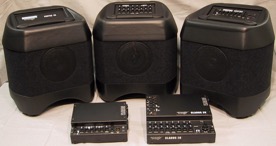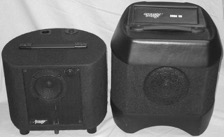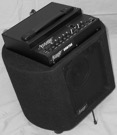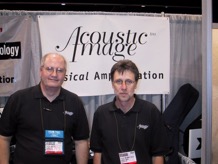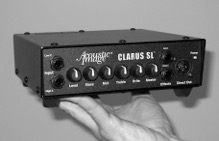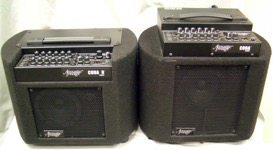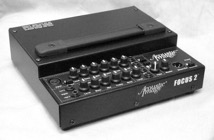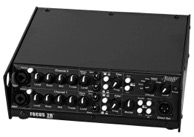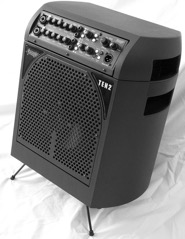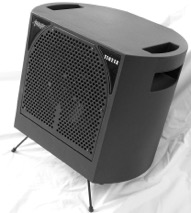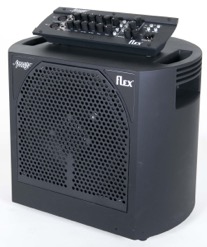
Vol 12, Number 1, Winter 2017, Raleigh, NC |
||||||||||||
|
CELEBRATING THE PAST. Twenty years ago, the very first Acoustic Image amplifier was home made by Rick Jones in Raleigh, North Carolina. Since then, much has changed. We’ve refined our designs, developed new technologies, and expanded our product line to include upwards of ten groundbreaking amp heads, combos and cabs—with more on the way. At the same time, a lot hasn’t changed. In fact, the AI philosophy, focus, and basic concepts haven’t wavered from day one. Our products still use downfiring low frequency drivers, unique enclosure shapes and materials, and switchmode power supplies and class D power amps to deliver superior full-range frequency response, fidelity and transparency—to accurately reproduce the sound of all instruments, including voice. And satisfied musicians are still telling our story for us. Because other companies continue to follow our lead, there are now plenty of small, lightweight products on the market. Some of the heads may even look like ours. But that’s where the similarity stops. Because we do our own designs, we have a distinctly different sound…one that’s more musical…one that delivers the natural sound of the instrument, only louder, without the whir of cooling fans. Bottom line, we’re committed to make products that offer better sound from better technology — and to stand behind every one of them. So we assemble every amp and combo in the U.S.A…play and strenuously test each one before it leaves our hands…offer the industry's best warranty…and carefully select the retailers who represent us around the world. We’re also committed to a close working relationship with musicians. So if you have questions or feedback, drop us an email. We’d love you to be an important part of the next two decades at Acoustic Image. Recollections of the first 20 years of Acoustic Image By Rick Jones My first serious bass amplifier was an Ampeg B15. But, after lugging its 80 pounds up a flight of stairs for the umpteenth time, I’d had enough. Hauling an amp like that and an acoustic bass to a gig was just too much. So I downsized to a Roland Cube 60 (remember the sickly orange color?). Unfortunately, it and its Polytone replacement sounded terrible. The input impedance wasn’t right for a piezo pickup and the amp/speaker voicing for an electric bass gave the nasal quality that string bass players called the “sound of the 80’s”. Ugh! As a working bass player and an electrical engineer who once interviewed at ElectroVoice, I thought I could do better than the typical commercially available combo amps. So I got a GK head and started designing my own speakers. At first, I came up with a pole mounted version like the Bose model that some of the top players used and coupled it with a subwoofer. It sounded pretty good. But at one gig, I was trying to get my bass, amp head, mounting pole and two speakers on a small elevator along with the vibes player and his instrument when I realized I was no better off than with my B15. The sound was better, but transporting the rig was worse, if anything. It was time to rethink the approach. And that was the beginning of AI. Over the period of several years, I experimented with various designs for compact speaker systems, each of which got plenty of field testing in the one or two gigs a week I was playing. Eventually, it dawned on me that combining a downfiring subwoofer with a forward firing speaker in a cylindrical enclosure would result in a full range speaker system that could be compact and lightweight. With lots of feedback from bandmates and fellow bass players, I refined the design to the point where I was very happy with it and other players were asking if I could make them one. So, I decided to start a company and called it Acoustic Image. My plan was to make three or four speakers at a time at home and sell them through ads in various magazines. This was in 1997. About the same time, I got involved with a fledgling amplifier company that was designing commercial Class D amplifiers and selling them in the OEM market. I was a venture capital “angel” investor and saw the opportunity to develop some complementary technology for my emerging speaker business. My first product was a 1x10 plus 1x5 speaker system that I called the D10. I used that name because the speaker cabinet was a flattened cylinder that when viewed from the top, looked like a “D.” I took some pictures of the cabinet along with my bass in my living room and created an ad that I put in the classified section of Bass Player and got responses from all over the world. Over the next year or so, I built and shipped a few dozen cabinets. All of the local players in Raleigh where Acoustic Image was located had them. Using the Class D amp technology from the company I was involved with, I upgraded the D10 to a powered cabinet and then to a combo I called the CD10. A few of those were sold, but by mid-1998, I decided to try to manufacture on a larger scale and get out of my garage. We moved into our own building at Miami Blvd. in Durham NC (next to Boss Man’s Diner) and got down to designing and putting the processes together to make our first product, the Model 310 BA Contra combo amp. We built a couple of prototypes, created some marketing materials and went to the Winter NAMM show in January of 1999. The small size and great sound of the Contra created some interest at NAMM. Many players came by to try it (including Victor Wooten) and it ended up in a montage of other products on the cover of the May 1999 Bass Player. It didn’t hurt that our booth was next to that of the great bass maker Mike Lull. Because of that, we had some fine instruments to demo our amps. Expectations were set at the show and orders started coming in. I hired Paul and Chris (who are still with me, Paul continuously and Chris off and on while he toured with various bands and got a tech degree) and we got underway. Predictably, there were design issues and manufacturing delays and it was October of 1999 before we shipped our first products. But, the Contras were a hit and we were off and running. After we got the Contra going, we decided to take the electronics out of the combo and create a compact amp head. We called it the Clarus. I took the prototype with me in the spring of 2000 on vacation with my family to New York City. While there, I went down to 48th Street (the former mecca of music stores) and took the Clarus into Rudy’s. I set it on the counter, told them what it was, and said I’d leave it overnight to let them test it to see what they thought. Remember, this was 17 years ago and the Clarus was a cigar box size, five-pound, 200W amp. There was nothing like it on the market at the time. When I came back the next day to pick it up, they said they wanted an exclusive to sell it!
Up to mid 2001, I was working a “day gig” at a high tech company I had cofounded in the late 80s. Acoustic Image was a few hours a day, part time job. But, the “dot-com” tech bubble that burst in 2001 resulted in the demise of my company and I had to look for other employment. I took a teaching/research position at Duke University but a few months into that job, we began designing an upgraded version of our amps and combos which we called “Series II”. Soon, the Acoustic Image business was growing and demanding more of my time and it was clear to me that my heart wasn’t in academia, so I quit and made Acoustic Image my full time gig. It was, in effect, a second career for me. At that time, we added an extension cabinet, a two-channel combo (Coda) and two-channel head (Clarus 2R) to complete our Series I product line. A family portrait of the products is shown above.
By 2002, we had designed a new generation of our products we called Series II. The goal was to further reduce the size and weight of the combos and to add features to the heads. The photo here shows the comparison between the SI and SII extension cabinets. The SII Contra is also shown. To promote our growing business, we attended various trade shows. Below is a photo of Paul and I at the Summer NAMM show in 2002. We were getting to meet a lot of customers and hear feedback that improved our products.
I still wanted to create the ultimate compact amp head so we started the design of a switched mode power supply to go with our Class D amp. The result was the Clarus SL, a completely unique 2.5 pound, 250W single channel amp. We called it the SL because it was “smaller and lighter” and the first units were shipped in April of 2004. To emphasize the small size,we showed the amp held in one hand. The photo here is the one we used in our very limited advertising. The SL was expensive (it sold for about $1000) but it was a hit. We added effects for the guitar market and called it the Clarus SL-R. Today’s Clarus SL is basically the same size but has more power (600W) and sells for a lot less ($599).
I wasn’t happy how the amp head just sat on the top of the cabinet in the SII models, so after a year or two, we refined the design and came out with the Series IIa. A comparison to the SII version is shown here. About that time, we began using neo woofers, so our combos became even lighter. We also expanded our switched mode power supply design for more power and came out with the Focus line of heads. The Focus amps were initially 600W and later 800W. The SII Focus and SIII Focus heads are shown below. At the time of their release, these were the smallest and most powerful amp heads on the market.
The biggest refinement in our product line came when we designed a molded speaker cabinet to achieve the lowest weight possible while improving looks. It took a while and was expensive (the mold for the cabinet is the size of a Volkswagen Beetle!) but it was worth it — the Coda R was a 20-pound, 400W combo. After initial production delays the first units were shipped in November of 2005 and customers were happy! The SIII Coda R is shown below. With some minor variations, we still use the same cabinet.
By 2006, the business had grown enough that we needed a larger facility. We moved to our current 5000-square-foot building early that year. In 2009, we expanded our combo product line by adding a 2x10 speaker configuration. Another molded cabinet was designed and we expanded on the downfiring woofer concept by adding a complementary front firing woofer. A tweeter completed the system. The result was the Ten2 and Ten2EX shown below. The Ten2 was the smallest and lightest 2x10 speaker system on the market. And remains so today. It has been a big hit, with its sales rivalling that of the Coda 1x10 combo.
In 2011, I started the redesign of our preamp circuit with the intention of producing the ultimate in preamplification for our products. At the same time, we undertook the design of a no-compromise powered speaker that would pair with our new preamp to create the best combo amp we could make. It took a couple of years but in the fall of 2013, we introduced the Flex System shown below. Over the years, as a result of Acoustic Image, I have been fortunate to interact with many of my musical heroes. Typically, they have been unassuming and very helpful. One day, the phone rang. The caller said “My name is Eddie Gomez. I’m a bass player and I’m interested in your products.” My response: “I think I know who you are!” Guitarist Pat Martino also called after playing through a friend’s Acoustic Image amp and wanted to get one. Once he got it, he called back and offered his endorsement of our products. That resulted in a series of small advertisements we ran that said “Pat Martino knows….and so can you.”
But while the unpaid help of big names is flattering, “average” musicians are even more important to us. These are the people who use the products on a daily basis and who find the good things and the bad things and tell us about them. Our products improve as a result. These are people who try other instruments and tell us what works and what doesn’t—players who have purchased many of our amps and cabs over the years…who own a few generations of the products and whose unflagging support has made our business what it is today. In fact, it is very interesting to me how the power of “word of mouth” can make a product successful in this internet age. When we started, we didn’t have the means of larger companies to reach the mass market through paid artist endorsements and large scale multimedia advertising. So the internet became the way that word of our products reached the market. Today, a happy musician anywhere in the world posts about Acoustic Image on a message board and many other players become interested. Effectively, every customer becomes a potential endorser for our products. Of course, over the past two decades, our dealers and distributors have also played a critical role in helping us to grow in North America and around the globe. Whether brick-and-mortar or Web based, any organization selling AI products shares our commitment to fair dealing and attentive customer service. Looking back, I knew our products had arrived when I got to a concert gig I was playing a few years ago. I set my bass and Coda on the stage and started to unpack and get set up. I used to hear “what the hell is that?” But this time the sound engineer stopped and looked as he came up to connect the amp to the house system. “Those are great amps,” he said. “And do you know that the guy who designs and builds them lives right here in Raleigh!” My response: “Yeah and he’s handsome too!” |
